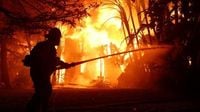On September 25, 2025, the Los Angeles County Board of Supervisors unveiled a sweeping 133-page independent report on the county’s response to the catastrophic January wildfires that swept through Altadena, Pacific Palisades, and neighboring communities. Compiled by the McChrystal Group, the report offers a sobering look at the strengths and shortcomings of the county’s emergency alert and evacuation systems during the Eaton and Palisades fires, which killed 31 people and destroyed more than 1,600 properties. While the review does not point to a single failure, it exposes a web of outdated policies, communication breakdowns, and resource shortages that collectively hampered the response when residents needed it most.
According to KABC, the after-action report was commissioned by the Board of Supervisors shortly after the January 7 blazes, which were fueled by hurricane-force winds and left devastation in their wake. The fires struck with such ferocity that firefighting aircraft were grounded and widespread power outages crippled communication infrastructure. The report found that “outdated policies, inconsistent practices and communications vulnerabilities” slowed the county’s response, especially in getting timely evacuation warnings to those in harm’s way.
One of the most glaring issues highlighted in the report was the hours-long delay in issuing evacuation orders to thousands of residents in west Altadena—even after flames had already been reported in the area. Tragically, 18 of the 19 people killed in the Eaton Fire perished on Altadena’s westside, several miles from where the fire began. The Associated Press noted that some residents didn’t receive emergency alerts until well after their homes had already caught fire. The report makes it clear: there was no single person or agency to blame. Instead, it points to a tangled mix of “interagency cooperation issues” and unclear decision-making roles around evacuation authority, as well as outdated and inconsistent policies and protocols.
The problems didn’t end there. The review found critical staffing shortages, including a high number of sheriff’s deputy vacancies and an under-resourced Office of Emergency Management (OEM). According to LAist, the OEM had begun preparing for the predicted heavy winds as early as January 3, but an experienced staff member was away for training, leaving less-experienced personnel to fill key roles. Compounding the problem, only four OEM staffers were trained on the county’s new emergency notification software, Genasys, when the fires struck. The report states, “While frontline responders acted decisively and, in many cases, heroically, in the face of extraordinary conditions, the events underscored the need for clearer policies, stronger training, integrated tools, and improved public communication.”
The county’s emergency alert process itself was convoluted, involving multiple steps and several leadership roles. For example, during the Palisades Fire, the Fire and Sheriff’s Departments would identify evacuation zones and communicate them to an OEM representative at the Incident Command Center. That person would then relay the information—sometimes by phone or text—to another OEM staffer at the Emergency Operations Center, who would finally update the alert system and trigger a public notification. This process could take between 20 and 30 minutes—an improvement over the previous 30 to 60 minutes, but still far too slow when flames are bearing down on homes. Even with this process, many alert systems required residents to opt in, meaning those unaware or not registered with services like Alert Los Angeles County, Genasys PROTECT, or WatchDuty missed critical warnings.
Communication breakdowns were further exacerbated by technology failures. First responders and incident commanders struggled to share real-time information due to unreliable cell connectivity, inconsistent field reporting, and the use of various unconnected platforms. As LAist reported, “The extreme and rapidly moving fire conditions challenged the situational awareness of fire and law enforcement first responders, making it difficult to communicate the fire’s location to the public.” In the Eaton Fire, hurricane-force winds grounded aerial surveillance resources almost immediately, robbing responders of a vital tool for tracking the fire’s spread.
Geography and weather played a role as well. The mountainous terrain where both fires burned, coupled with downed power lines and heavy smoke, often shut down cellphone towers and degraded signal strength. This meant that even when alerts were sent, they sometimes failed to reach residents in the most threatened areas. The report also found that public education on evacuation zones and preparedness was insufficient—many residents didn’t know the names of their evacuation zones or what to do when a warning arrived.
Staffing shortages were a recurring theme. The Los Angeles County Sheriff’s Department and the Office of Emergency Management were both highlighted as being critically understaffed, which hindered the response. According to The Desert Sun, while some staffing increases for OEM have been approved, they “have not been sufficient to build the professional capacity necessary for effective emergency management in the nation’s most populous county.”
Supervisor Kathryn Barger, who called for the independent review, emphasized that the report was not about assigning blame. “This isn’t about pointing fingers,” Barger said. “It’s about learning lessons, improving safety, and restoring public trust. My commitment is straightforward: we will take these findings and turn them into action so our communities are better protected in the future.”
The report’s recommendations are extensive. It calls for restructuring and increasing staffing at the Office of Emergency Management, updating and clarifying emergency preparedness training and policies, upgrading obsolete alert systems, and investing in public education about emergencies. It also urges the county to standardize roles and responsibilities for issuing evacuation orders, improve cross-disciplinary training among agencies, and ensure that alert and evacuation policies are clear, current, and uniformly applied across jurisdictions. The review analyzed over 150,000 alert and evacuation data records, GPS tracking of responding units, community feedback from public sessions, and interviews with emergency responders and senior officials.
Importantly, the report only examined the actions of county departments and did not assess the roles of federal, state, or city agencies. Notably, city agencies—including those in Los Angeles—declined interviews for the county’s review, even as controversies swirled around their own responses. The causes of the Eaton and Palisades fires remain under investigation.
These findings echo problems seen in other major wildfires across the United States, from California’s 2017 Tubbs Fire and 2018 Camp Fire to Colorado’s 2021 Marshall Fire and Hawaii’s devastating 2023 Lahaina Fire. In each case, delayed or failed emergency alerts contributed to tragic loss of life and property.
As Los Angeles County prepares for a more comprehensive review at the Board of Supervisors meeting on September 30, officials and residents alike are left grappling with the lessons of January’s disaster. The hope is that, with decisive reforms and a renewed commitment to preparedness, the county will be better equipped when the next emergency arrives.





